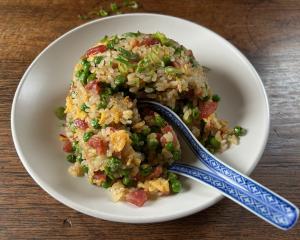

"But as someone who would never be described as tidy or precise, who is not prim or proper, who is not a scientist, I reject those sentiments."
However, Roman, who is New York-based, does enjoy licking the leftover pudding at the bottom of the pot and cannot help but slice the pie before it has properly cooled or will only use one bowl to mix a cake batter if it means she does not have to wash another thing, and avoids using anything that plugs in at all cost.
"Desserts, baking whatever we want to call it here should be for anyone, at anytime, requiring little more than two hands and a modicum of patience."
She admits desserts are not essential to life but it is a nice thing to remind people and each other that they live for more than just necessity.
Her style, she says could be described as "rustic", "carefree", "approachable" and are not perfect even though she trained as a pastry chef in a restaurant kitchen.
"I admit that I didn’t so much choose this aesthetic as this aesthetic chose me."
Some of her recipes do not require an oven or even a stovetop.
"I wanted to write a dessert book that celebrated the excellence of basicness rather than distract with needless complexities."
There are options to fancy things up if the cook chooses but it is always good to have a basic, foolproof recipe to start with.
"I’m still not an expert. My pies still leak, cheesecakes crack and pound cakes are pulled from the oven before they’re fully baked. Lopsided and wonky, occasionally almost burned, unevenly frosted, my desserts are consistently imperfect. But perfection is boring."
To help bakers along the way, she has some advice — read a recipe from start to finish before making it, kitchen scales take out the guesswork and all ovens are very different, so putting a thermometer in the oven gives a better sense of the temperature and put the oven rack at the centre.
While she believes quality baked goods can be made no matter the quality of ingredients or where they are purchased, she gives a run-down on the basic ingredients she likes to use when it comes to flour, butter, eggs and sugar.
Food processors and mixers are helpful but are not needed to make the recipes in her book Sweet Enough: A Baking Book.
"Some of the best recipes require almost nothing at all, save for maybe a bowl, perhaps a baking sheet and a flimsy piece of baking paper. But in a perfect world you have a few additional pieces of "equipment" to make your experience more stress-free."
For Roman the pie, tart or galette is her favourite so they are the first and longest chapter in her book.
"The balance and contrast of exterior textures and interior flavours in one slice really ‘do it all’ for me."
There are also chapters for cakes, puddings, cookies, frozen "things", too much fruit and morning tea and snacks.
Chocolate sour cream pound cake
For a person who’s ‘‘not that into chocolate’’, it seems unlikely that I’d give valuable recipe real estate to another chocolate cake, when the other chocolate cake does such a good job at being a chocolate cake. But this chocolate cake is a different thing
altogether. This chocolate cake, dense and buttery, deeply chocolatey, and studded with even more chunks of chocolate, is directly inspired by the only muffin I have ever cared about: the chocolate chocolate-chip muffin from Costco. I’ve rewritten it to be
a pound cake since, for whatever reason, I’m just no longer a MuffinPerson™ (although I’m sure this recipe would make for a great muffin). It’s less for frosting and layering, more for slicing and snacking.

Ingredients
180g (1¼) cups plain (all-purpose) flour
85g (¾ cup) cocoa powder
1½ tsp (6g) baking powder
1¾ tsp (7g) kosher salt
170g unsalted butter
330g (1½ cups) granulated sugar
1 tsp (5g) vanilla extract
2 large eggs
2 large egg yolks
220g (1 cup) sour cream or full-cream yoghurt
225–285g chocolate chips or chopped-up bars (optional)
3 Tbsp demerara or raw sugar (or more granulated sugar)
Method
Preheat the oven to 180degC . Line a 23cm by 10cm loaf tin with baking paper.
In a medium bowl, whisk together the flour, cocoa powder, baking powder and salt.
In a stand mixer fitted with a paddle (or using a large bowl and a hand-held mixer), beat the butter, granulated sugar and vanilla together until extremely pale and fluffy, 4–5 minutes. Scrape down the side of the bowl and add the eggs and egg yolks, one at a time, beating after each to incorporate. Continue beating until the mixture is smooth, fluffy and well incorporated, 2–3 minutes.
With the mixer on low speed, add about half the flour mixture, followed by the sour cream, followed by the remaining flour mixture — the idea being, you don’t want to add too much liquid to the egg mixture, or it’ll have a hard time incorporating, and you don’t want to overmix the flour, which will give you a tough cake. Just before everything is incorporated, add three-quarters of the chocolate, if using.
Scrape the batter into the loaf tin. Sprinkle with the remaining chocolate (if using), and the demerara sugar. Bake until the cake is puffed, considerably taller, and pulling away from the side of the tin, 65–75 minutes (pound cakes always take longer than you think).
Cool entirely before removing from the tin.
Eat with:
A dish of creme fraiche, or nothing at all.
Do ahead:
The richness of this pound cake means it can last at least five days on the counter, tightly wrapped, up to one week refrigerated, or one month frozen.
Deep-dish apple galette
I would argue that for all the fruits available to turn into a galette, the apple is the most well-behaved candidate. Rarely too juicy, a pleasant balance of sweet and tart, but not too much of one or the other, it’s just a kind of middle-of-the-road fruit that always tastes like itself. If you’re picking up on some subtext that suggests I think apples are a little boring, well, you’re right. But sometimes, I like boring. Sometimes, safe, reliable and a little milquetoast is exactly what you want. Plus, that’s what the honey and apple cider vinegar are there for — to keep things interesting. Anyway, a deep-dish galette is just like a regular galette, except baked in a vessel that facilitates a ... deep dish. Think tall. Think open-faced pie. As for the chosen vessel, a 23cm springform tin is really what you want here — it has high sides that give the crust plenty of structure and support, plus the chance to have those extremely dramatic golden brown walls made of buttery crust. Of course, a deep pie dish will work, and so will a cake tin! You could even bake this in a deep 23cm–25cm cast-iron skillet — the choices are limitless.
You may have a bit of excess dough, but I figured in this case it was better to have too much rather than not enough.

For the dough
435g (3 cups) plain (all-purpose) flour
2 Tbsp (25g) sugar
1½ tsp (6g) kosher salt
340g cold unsalted butter, cut into 2.5cm pieces
1 Tbsp (15g) apple cider vinegar
80g (⅓ cup) ice water
For the filling
1.15kg firm, tart baking apples, cored and thinly sliced (about 8 cups)
240g (¾ cup) mild-flavoured honey
110g (½ cup) sugar
2 Tbsp (20g) plain (all-purpose) flour, plus more for dusting
1 Tbsp (15g) apple cider vinegar or fresh lemon juice
1½ tsp (3g) ground cinnamon
For assembly and serving
cooking spray, softened butter or oil, for greasing
plain (all-purpose) flour, for dusting
1 large egg
3 Tbsp white sesame seeds (optional)
2 Tbsp sugar
flaky sea salt, for sprinkling
vanilla ice cream
Method
Make the dough: In a large bowl, combine the flour, sugar and salt, using your hands to mix well.
Add the butter to the bowl and use your palms and fingertips to smash the bits into the flour until you have large, flat butter pieces that are evenly distributed throughout the flour. Pop the bowl into the freezer for 5 minutes or so.
In a measuring cup, combine the vinegar and ice water and drizzle it over the flour mixture. Like you’re running your hands through sand, deliberately yet delicately mix the water into the buttery flour until it forms a shaggy clump. Resist the urge to add more water, knowing that as you knead further, it will become less dry.
Turn the dough out on to a work surface and use your palms to knead it lightly until the shaggy clump transforms into a slightly less shaggy mass of dough. (It should still be relatively shaggy.) Pat the dough into a disc about 2.5cm thick, rotating it to create a nice round. Wrap in plastic or place in a resealable plastic bag and chill until firm, at least 2 hours.
Preheat the oven to 190degC . Remove the dough from the refrigerator and let it soften slightly at room temperature — about 10 minutes or so.
Meanwhile, make the filling: In a large bowl, combine the apples, honey, sugar, the 2 tablespoons flour, the vinegar and cinnamon. Toss the ingredients so every slice of apple is evenly coated.
To assemble:
Lightly grease a 23cm springform tin, or a 23cm deep-dish pie dish. On a lightly floured work surface, roll the dough out to a round about 45cm in diameter. Transfer the dough to the tin or dish, letting it slump to line the bottom and letting the overhang remain.
Transfer the apple mixture (and any juices that have accumulated) to the tin or dish. Drape the excess dough over the filling, covering the apples by 4cm–5cm; feel free to trim any dough that feels truly excessive.
Whisk the egg with a teaspoon of water and use it to brush the exposed crust. Sprinkle with sesame seeds (if using), the sugar and a little flaky salt. Place the galette on a baking sheet, for easy cleanup should anything bubble over. Bake for 1 hour 5 minutes, to 1 hour 15 minutes, until the crust is deeply golden brown (about the colour of a well-baked croissant), the apples are tender, and the juices are bubbling and thickened. Let the galette cool completely, for at least 2 hours, before slicing and eating — preferably with lots of ice cream.
Eat with:
I like deep-dish galettes for holidays. They’re just so large and grand, they really do feel celebratory.
I especially enjoy them for Rosh Hashanah and Thanksgiving, two times you might already expect to see apples and honey together.
Do ahead:
The dough can be made 5 days ahead, wrapped and refrigerated. The galette can and should be baked a day ahead; store loosely covered at room temperature. If you like, you can bake it up to 2 days ahead, then wrap in foil and store in the refrigerator; it can be gently warmed in a 190degC oven to take the chill off.
Cheesy, salty, savoury scones
This feels like a weird thing to casually drop into a dessert book, but I absolutely, 100%, will always and forever prefer savoury to sweet. I would rather eat an onion than an apple, lick salt than sugar. In case you feel the same, first, thank you for buying this
book anyway — I hope it inspires you to give some sweet things a try. Second, you will adore this recipe. I believe in a thick cream/sour cream-based scone, rather than a laminated scone (which to me, is more of what we call a biscuit in the US). What you lose in "flakiness", you make up for in richness, tenderness and never-dryness.

Ingredients
120g (½ cup) thick (double/heavy) cream, plus more for brushing
110g (½ cup) sour cream
255g (1¾ cups) plain (all-purpose) flour, plus more for dusting
125 g (1½ cups) finely grated Parmesan or pecorino, plus more for sprinkling
2–3 tsp coarsely ground black pepper, plus more for sprinkling
1 Tbsp (12g) baking powder
1 Tbsp (12g) sugar
1¼ tsp (5g) kosher salt
¼ cup (12g) finely chopped fresh dill (optional)
1 medium leek, or 6 spring onions, white and light-green parts only, very thinly sliced
11g cold unsalted butter, cut into small pieces
flaky sea salt, for sprinkling
Method
Preheat the oven to 220degC . Line a baking sheet with baking paper.
In a small bowl, mix together the thick cream and sour cream. In a large bowl, combine the flour, Parmesan, pepper, baking powder, sugar and kosher salt. Add the dill, if using , and all but a small handful of the sliced leek (reserve the rest to top the scones before baking). Whisk together until well blended.
Using your hands (never a food processor!), add the butter and smash the butter into the flour to get large-ish, flat, even pieces.
Most of the butter should be smushed, resembling flakes, rather than large chunks or cubes — not unlike pie dough before you add water, or American-style biscuits before the buttermilk.
Using a spoon, stir in the sour cream mixture, then use your hands to gently knead a few times just until a shaggy dough comes together.
Turn the dough out on to a lightly floured work surface. Pat it into about a 15cm x 23cm rectangle, about 4cm thick. Cut it in half lengthways, then in half crossways, to make four pieces.
Cut each piece in half on the diagonal, so you have eight triangles. Place the scones on the baking sheet about 2.5cm apart. (For extra fluffy scones, or if the dough is feeling particularly soft or it’s particularly warm in your kitchen, refrigerate 20–30 minutes before baking.)
Brush a little cream on top of the scones. Sprinkle with flaky salt and more pepper, and scatter the reserved leek slices on top. Bake until golden brown on the tops and bottoms, 25–30 minutes.
Eat with:
Fried eggs, sausages, an entire stick of softened butter.
Do ahead:
The dough can be made 6–8 hours ahead, then covered and refrigerated. The scones can be baked a few hours ahead. Reheat before serving, if desired.












